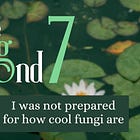The Frog Pond #9: Fairy Rings (and Circles)
Or, the facts behind a piece of fungus fairy folklore.

The height of summer has shrunk the pond after weeks without rain. There is a withered ring of grass around the edge now. Small, white-capped mushrooms have begun to sprout within it. You’ve heard tales of fae creatures whisking people away to another realm through rings like this. Despite standing in your swimming gear, you hesitate to jump in.
This month’s Frog Pond is keeping cool, calm, and collected.
Mist-erious knowledge
A small, bright green frog hops to sit beside you. Its black eyes look from you, to the pond, and back. As if shrugging, the frog wiggles and hops forward through the ring. It reaches the other side unharmed, though you could swear the light hits it differently now.
It’s now or never. You’re tempted to close your eyes, but instead you hold your breath and hop into the ring.
What is a fairy ring?
In the simplest terms, a fairy ring is anywhere that a circle (or sometimes an arc) of mushrooms1 appear naturally. These can be found mainly in forests and grasslands2.
Fairy rings can have a necrotic zone, where grass has withered or died due to mycelium taking root underground, depleting the nitrogen, and fruiting mushrooms in a circular pattern outwards from the spores’ origin point3.
But fairy rings don’t always cause withering. The purple-spored puffball actually causes grass to grow thicker when it fruits4. As usual, fungi contain multitudes.
Multiple spores are required for the mycelia to mate and spread5. Fairy rings can grow larger over time as the fungus must search for more nutrients. Annual radial growth rates can range from 10 cm to 25 cm6.
What kind of mushrooms make fairy rings?
Marasmius oreades, commonly known as Fairy Ring Mushrooms, are the most common type found in this pattern, go figure. These mushrooms are small (2-3 cm in diameter), pale brown, and often grow in large numbers7.
Many other types of mushrooms can form fairy rings. There are to date roughly 60 varieties of fungi known to make fairy circles. One (the Monk’s Head in northeast France) has spread as large as 300 ft. in diameter and lasted 700 years8.
A curated selection of fun-named fungi that can make fairy rings:
- The Blusher
- Sweating Mushroom / Ivory Funnel
- Fool’s Funnel
- The Vomiter
- Shaggy Parasol
- Blue-Foot Webcap
- Dung-Loving Bird’s Nest
- Pig’s Ears
- Devil’s Snuff-Box
- Scaly Hedgehog
Free vs. Tethered
While many fairy rings are formed by “free” fungi as above, some are formed by mycorrhizal fungi which are tethered to one or more plants9. Mycorrhizal fungi form symbiotic relationships with the root systems of plants by providing, regulating, and transporting nutrition between itself and the plants10.
Centuries of warnings
Fairy rings, like many natural phenomena, have a rich history in folklore. Their French and German names translate to “witches’ circles” and “witches’ rings” respectively11. There’s a Dutch superstition that these rings show where the Devil puts his milk churn, an Austrian story connects the rings to fiery dragon tails, a French tradition has rings being guarded by giant bug-eye toads that curse you (which, hell yes), and in the Philippines the rings have been associated with spirits12.
Some of the most well known and preserved legends come from Britain and Ireland. Most of their stories focus on elves/fairies dancing in fairy rings. Entering fairy rings is always warned against, though the consequences can be anything from becoming lost in illusions/madness, to being cursed with bad luck, to dying at a young age, to being unable to leave the circle13.
Many tales promise that the fairy rings will grow back no matter how you destroy them. This makes sense as a folk tale given the nature of the mushrooms that create the rings—uprooting a mushroom doesn’t destroy the fungus itself at the centre of the fairy ring, which can later grow another mushroom in its place14.
Is there real danger in fairy rings?
While the ground itself poses no threat to an accidental interloper, the mushrooms themselves certainly can. Some fairy ring mushrooms are harmless, even edible, but others like the Death Cap are extremely poisonous15.
Never eat or handle a mushroom you can’t identify, especially those you encounter in the wild!!
Otherwise, the only danger free fairy rings may have is to your lawn care16.
How are fairy rings different from fairy circles?
A completely unrelated phenomena is often confused etymologically. Fairy circles are naturally occurring circles of barren land in fields, sand, or clay17, often with taller and fuller grass at their border18. They appear in groups forming a hexagonal pattern and have been found in Namibia, South Africa, and Western Australia19. There’s no one confirmed cause for these circles, but theories range from termite activity to grass competition to hydrogen-loving microbes to toxins left over from dead plants20 to a host of other factors.
Similarly to fairy rings though, one folk tale from Namibia is that the fairy circles are formed by the poison breath of dragons21—very similar to the Austrian theory above!
A word from a passing frog
July was a good month for querying and drafting! And good news all around: We managed to sign an apartment, so we are officially moving by the end of this month!! This is a huge change in my life, having lived in Ontario for the past 6 years while supporting my SO through his PhD. We’re very excited to be back home soon :)
Querying
Submitted: 130 (+13 since last month)
Rejections: 106 (+13 since last month)
Active Full Requests: 6 (+2 since last month)
I reached over 100 rejections!!! It’s been about 9 months of submitting and I’m really proud of myself! I’ll be enjoying my reward in August with a spa day.
Otherwise, I’ve still got agents left on my list to query, with about 20 agents still to hear back from plus the fulls. Feeling really hopeful lately, even as I get closer to the end of this book’s query journey!
Drafting
I participated in Camp NaNo this month (a make-your-own-writing-goal month-long event by the NaNoWriMo team) and won by passing 25k in my current project, my sci-fi eco-horror rewrite (TIE). Yay!
Drafting is still going well! I won’t have a lot of time to dedicated to it with the move, but I’ve got a lot of relief that I know I’ll be able to finish this whenever I have the time.
Reading
Sorrowland by Rivers Solomon: This eco-horror dystopian novel was mostly on my radar for the mushrooms, but it has a ton packed into its pages. The voice was super strong. The protagonist was both easy to root for and dynamic throughout the whole book, making surprising choices with complicated moral implications. This is a heavy book, especially for religious trauma and abuse, but it’s got such an interesting point of view (and the bonus of cool fungi fantasy).
Kiki’s Delivery Service by Eiko Kadono: As a fan of the Ghibli film, I never knew that Kiki’s Delivery Service was originally a novel! When it came up on Libby, I had to read it. It’s a very light read and has similar beats to most of the movie. The thing I found most interesting were the differences in overall themes. The novel focuses on Kiki’s confidence and acceptance by the townspeople in distinctly different ways than the movie, which focuses a lot more on Kiki’s creativity/magic and getting through burnout. Highly recommend, a great book it listen to while cleaning!
I’m also part way through Camp Zero by Michelle Min Sterling, Gideon the Ninth by Tamsyn Muir, and Emily Wilde's Encyclopaedia of Faeries by Heather Fawcett. All extremely different books and all really enjoyable so far!
You jumped into the ring, you know you did, but suddenly you’re turned the other way around. What just happened? You peer down beside your feet—wet, as is the rest of you, so you definitely swam—and the small, green frog is beside you again. It hops off towards the forest, but just as it reaches the tree line you could swear something glittering spreads on its back.
You towel off. The world around you appears brighter, bolder. Yet when you turn around at the edge of the clearing, there’s no circle of mushrooms around the pond anymore. Whatever purpose they served, it’s done now.
There are responsibilities and joys to get on with. Tea to ice, towels to dry, and words to write. The world keeps moving, even if the frog pond stays quiet, strange, and weirdly wonderful.
But maybe you’ll turn left again, the next time you go walking.
Footnotes
1
Another fungus-related Frog Pond! If you need a basic refresher on fungi, check out Frog Pond #7:

The Frog Pond #7: I was not prepared for how cool fungi areSARAH L. HAWTHORN·JUNE 1, 2023Read full story
2
https://en.wikisource.org/wiki/1911_Encyclop%C3%A6dia_Britannica/Fairy_Ring
3
https://www.anbg.gov.au/fungi/what-is-fungus.html
4
https://en.wikipedia.org/wiki/Fairy_ring and Böttcher, Helmuth M. Miracle Drugs. William Henemann Ltd. London 1963 p. 227
5
https://www.anbg.gov.au/fungi/mycelium.html
6
https://www.anbg.gov.au/fungi/mycelium.html
7
https://www.anbg.gov.au/fungi/mycelium.html
8
https://en.wikipedia.org/wiki/Fairy_ring and Gregory, P.H. (1982). "Fairy rings; Free and tethered". Bulletin of the British Mycological Society. 16 (2): 161–63. doi:10.1016/S0007-1528(82)80013-8.
9
https://www.anbg.gov.au/fungi/mycelium.html
10
11
https://archive.org/details/toadstoadstoolsn00morg Please click this link and look at the adorable toad on a toadstool on the cover!
12
https://archive.org/details/toadstoadstoolsn00morg
13
https://www.worldcat.org/title/635808806
14
https://books.google.ca/books?id=r7AZ4U2HA3UC&redir_esc=y
15
http://www.mushroomexpert.com/amanita_phalloides.html
16
https://www.planetnatural.com/pest-problem-solver/lawn-pests/fairy-rings/
17
18
19
http://news.bbc.co.uk/2/hi/africa/3587431.stm
20
http://upetd.up.ac.za/thesis/available/etd-01172008-125625/unrestricted/dissertation.pdf
21
https://www.nytimes.com/2013/03/29/science/fairy-circles-in-africa-may-be-work-of-termites.html?_r=0





